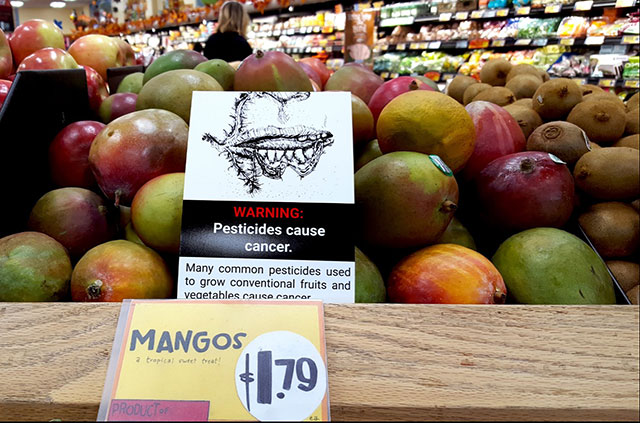
On a near daily basis, we are inundated with messages about the benefits of buying. In 2015, $180 billion worth of advertisements polluted our spaces, radio waves and TVs in the United States. These high-dollar promotions insist that an all-inclusive vacation will annihilate anxiety, and a chocolate bar can take the place of a significant other.
Rarely, however, do we hear about the negative effects of our purchases on the environment, other humans or ourselves. We tune out the sped-up list of negative pharmaceutical side effects. The small fine print is too small to bother reading. An article about the exploitation of young children by Hershey’s can be scanned and conveniently forgotten.
But there is one product that, in many countries, broadcasts its ills to the world: tobacco. After finally beginning a slow descent from politicians’ graces, cigarette companies are now often forced to include graphic warning labels on cartons. Rather than showcasing a beautiful young couple bonding over Virginia Slims, cigarette packaging must now help the potential buyer envision the lung cancer and tooth decay its contents may precipitate.
First introduced in Iceland in 1985, graphic warnings on cigarette labels began to spread in the early 2000s in spite of industry opposition. The Bulletin of the World Health Organization records Canada as the first country to require graphic warning labels in 2001, with many more countries following suit, including Brazil, Thailand and Australia.
Substantial evidence demonstrates that consumers are more likely to notice graphic warning labels than text-only labels. Graphic labels have also proven more effective at motivating smokers to quit.
Inspired by the effectiveness of graphic warning labels, I envisioned a reverse advertising strategy replicated in the realm of other goods. What if, like cigarette cartons, every product had to tell you its whole story — not in discrete fine print, but in brazen images?
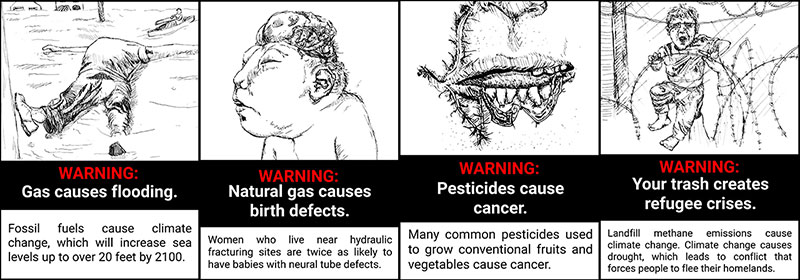 (Photo: Maya Silver)
(Photo: Maya Silver)
The Victims of Our Purchases
While tobacco graphic warning labels focus on harms to the user, products often also impact other humans, animals and the environment. Reverse advertising for products and commodities might warn prospective customers about:
Self-Risk: Like tobacco warning labels, these labels focus on risk to the consumer posed by, for example, pesticides, BPAs and other chemicals pervasive in products. A label depicting the negative health effects of parabens is more prominent and tangible than the word “propylparaben” in the ingredients list.
Human Rights Risks: These labels make consumers aware of the harm dealt to other human beings through their purchase. These take the conspicuous absence of a “Fair-Trade” stamp of approval to the next level through graphic, empathy-generating depictions of product victims, such as Thai slaves of the shrimp industry.
Non-Human Rights Risks: The third category of labels follows in the PETA tradition of visualizing the repulsive harm our commodities deal animals and the larger environment.
Reverse Advertising at the Pump and Beyond
To bring the idea of reverse advertising to life, I created labels for quotidian products and commodities. Below are four examples of these graphic warning labels in action.
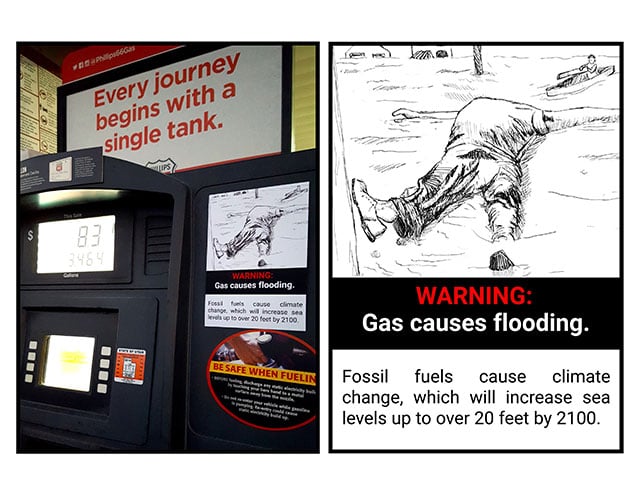 (Photo: Maya Silver)
(Photo: Maya Silver)
How does a trip to the gas station result in the displacement of people by the climate crisis? Fossil fuels, including the gas we use to power our vehicles, result in CO2 emissions that cause climate change. As oceanic thermal expansion accelerates and the Antarctic and Greenland ice sheets melt, the sea swells. Experts estimate seas will rise anywhere from 2.5 to 23 feet by the year 2100. Sea level rise will cause flooding and loss of life and property. It will also render regions that millions call home uninhabitable, contributing to the climate refugee issue lurking in our near future.
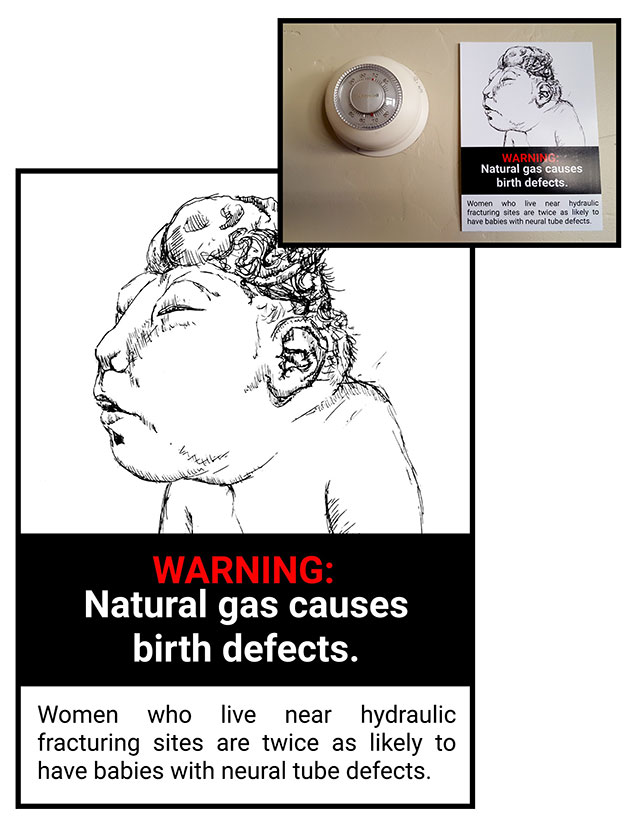 (Photo: Maya Silver)
(Photo: Maya Silver)
What about the human health risks of the seemingly innocuous and affordable natural gas that keeps us warm in the winter? Unless you source all of your home’s energy from renewable sources, your cold weather comfort comes at a cost unseen on your monthly utility bill. A 2014 study found that women who live within a 10-mile radius of a natural gas well were twice as likely to give birth to children with neural tube defects as depicted in this label.
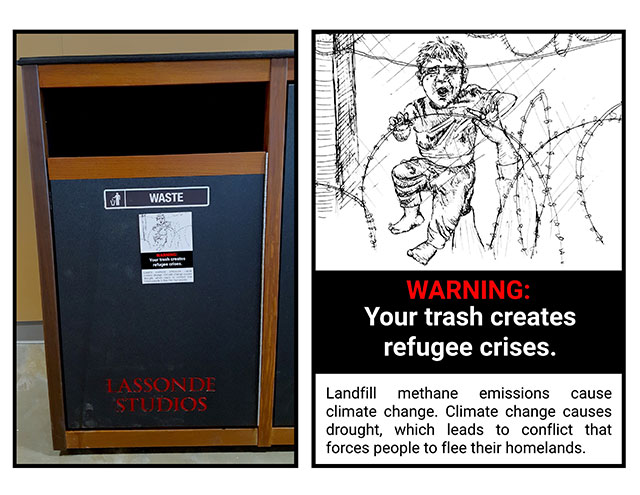 (Photo: Maya Silver)
(Photo: Maya Silver)
Recycling may be the low-hanging fruit of environmental action, but we still discard plenty. In 2014, landfills accounted for 20 percent of US emissions of methane, a potent greenhouse gas. Every time you toss your leftovers or junk the ample packaging enrobing your Amazon order, you ultimately contribute to the emissions causing climate change. Drought is just one of many impacts of climate change. Recently, a National Academy of Sciences study linked the severe three-year drought in Syria to the still extant conflict that erupted in 2011 and has displaced nearly 5 million people. And thus, your discarded Styrofoam to-go container indirectly forces others to flee their homes.
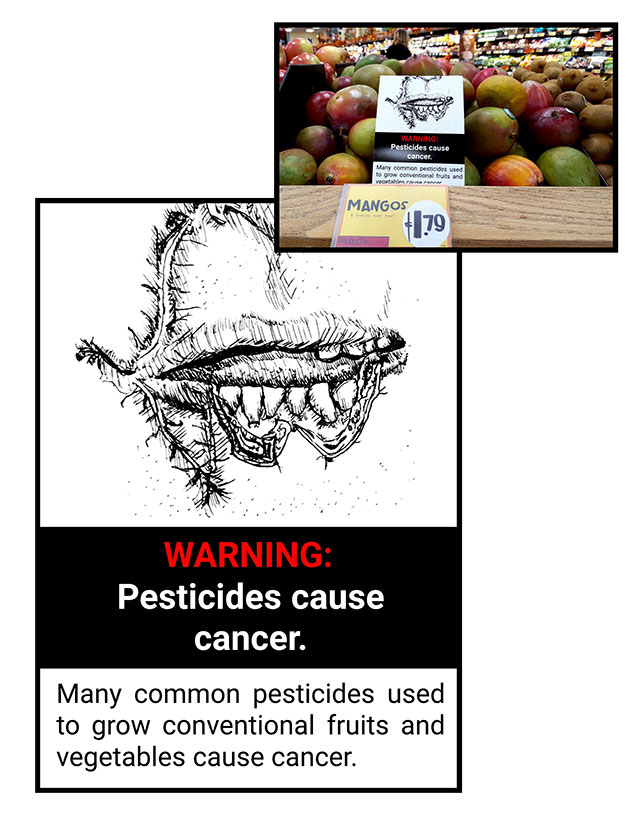 (Photo: Maya Silver)
(Photo: Maya Silver)
It’s hard to believe a strawberry innocuous in appearance might be related to a California farm worker’s cancer — or your own future diagnosis. However, studies have demonstrated the toxicity and potential health risks that common pesticides pose. A 2008-2009 President’s Cancer Panel report underscored these concerns, as well as the need for further research, cautioning that, “Pesticides … approved for use by the … EPA contain nearly 900 active ingredients, many of which are toxic.” The report also emphasizes that children are at a higher risk of pesticide-induced cancer, as well as farmers, who are susceptible to prostate cancer, skin cancer and lip cancer.
A Labeled World
We are all still trapped in the role of consumers. A zero-impact lifestyle is a near impossibility. But graphic warning labels for products and commodities would increase consumer awareness and make the tempting condition of blissful ignorance more difficult. Product advertising and branding should be required to portray all sides of the story, including those advocating on behalf of the environment, humanity and our own bodies.
What is the likelihood of our own government requiring corporations to include the whole story of all products? Quite poor, considering our country has yet to even enact legislation to require graphic warning labels on cigarette packaging. In 2009, a federal law required the FDA to issue a final ruling on graphic labels by June 22, 2011. With no final ruling yet issued, the American Cancer Society and other medical and advocacy organizations filed suit against the FDA on October 4, 2016.
Given the meager prospects of a federal mandate on product labeling, this is a project best undertaken by the people. If we want the whole story behind our products and actions, we need to undertake a guerilla reverse advertising campaign ourselves.
Join us in defending the truth before it’s too late
The future of independent journalism is uncertain, and the consequences of losing it are too grave to ignore. To ensure Truthout remains safe, strong, and free, we need to raise $27,000 in the next 24 hours. Every dollar raised goes directly toward the costs of producing news you can trust.
Please give what you can — because by supporting us with a tax-deductible donation, you’re not just preserving a source of news, you’re helping to safeguard what’s left of our democracy.